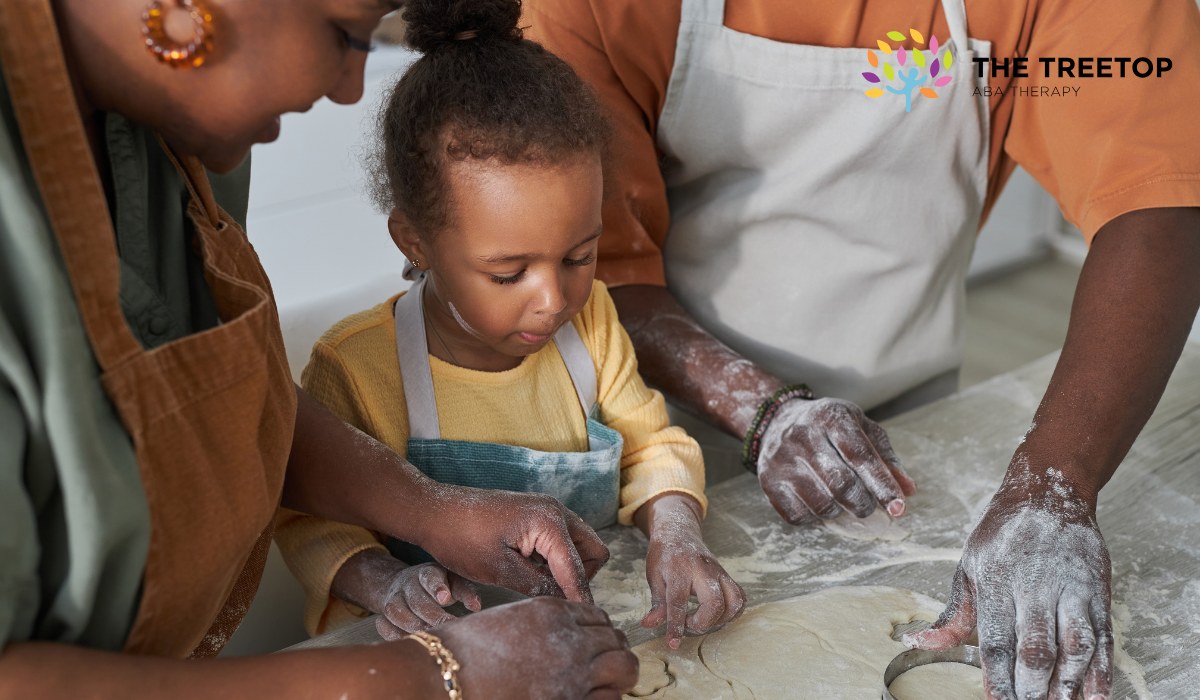Masking in Autism Explained: What It Is and Why It Matters

Written By:
Fact-checked By:
November 13, 2025
Masking in autism can hide true feelings and increase stress. Learn what it means, why it happens, and how to support authentic self-expression.

Key Points:
- Masking in autism involves hiding natural behaviors to fit in socially, which can increase stress and fatigue.
- Understanding why masking happens helps parents support authentic self-expression and emotional well-being.
- Effective strategies, including ABA therapy, can help children balance social expectations with staying true to themselves.
Autism presents in countless ways, and one behavior that often goes unnoticed is masking. Many children on the spectrum learn early that their natural behaviors—stimming, vocalizing, or unique social patterns—might be met with confusion, correction, or exclusion. To navigate these pressures, they may consciously or unconsciously "mask," or hide, parts of themselves.
Masking can look like imitating peers’ social behaviors, forcing eye contact, suppressing self-stimulatory actions, or carefully mirroring social norms. While these strategies may help children avoid judgment or bullying, they come with significant emotional costs. Parents and caregivers who understand masking can better support their child’s well-being and promote environments where authenticity is encouraged.
What Masking in Autism Looks Like
Children and teens who mask their autistic traits often present a very different picture in social situations than at home. The outward behaviors can be confusing: they may appear socially adept in class but anxious, withdrawn, or exhausted at home.
Common examples of masking include:
- Forcing eye contact: While eye contact is a natural social cue, some autistic children may overcompensate to appear engaged, even if it feels uncomfortable or overwhelming.
- Suppressing stimming behaviors: Movements such as hand-flapping, rocking, or finger-tapping might be hidden because of fear of negative reactions.
- Copying peers: Mimicking gestures, phrases, or conversational patterns can help a child blend in, but may require constant mental effort.
- Overthinking responses: Children may rehearse what to say or how to act, leading to exhaustion after social interactions.
- Downplaying interests: Passion for specific topics—like trains, numbers, or art—may be minimized to avoid standing out.
Recognizing these behaviors is the first step toward helping your child navigate social expectations without losing sight of their own identity.
Why Masking Happens
Understanding why children mask their autistic traits helps parents approach the issue with empathy rather than frustration. Masking is not about deception—it’s a coping mechanism.
Key reasons children mask include:
Social Pressure
Children quickly learn which behaviors are accepted or discouraged. Peer pressure, school expectations, and societal norms often reinforce the need to blend in.
Fear of Rejection
Autistic children may experience bullying or exclusion. Masking becomes a strategy to avoid criticism or social isolation.
Desire for Acceptance
Many children genuinely want to connect and be understood. Masking can feel like the only way to engage successfully with peers or teachers.
Internalized Messages
Repeated feedback about “wrong” behaviors can lead to self-criticism. Over time, children may believe their natural responses are unacceptable.
Misunderstanding of Social Cues
Some children mask because they have learned that misreading a social situation could have negative consequences, prompting them to carefully regulate behavior.
While masking can temporarily reduce social friction, it often comes with hidden costs that affect mental health.
The Hidden Costs of Masking
Masking may appear adaptive on the surface, but it can take a serious toll on children’s emotional and physical well-being.
Effects of prolonged masking include:
- Increased Anxiety and Stress: Constantly monitoring and adjusting behaviors is exhausting and can trigger ongoing anxiety.
- Burnout: Children may experience social burnout, where even simple interactions feel draining.
- Depression or Low Self-Esteem: Hiding one’s authentic self can lead to feelings of inadequacy or self-doubt.
- Delayed Identification of Needs: Masking can obscure signs of sensory sensitivities, learning differences, or emotional struggles, delaying support.
- Difficulty with Self-Expression: Children may struggle to identify and communicate their feelings, leading to frustration or meltdowns.
Understanding these consequences helps parents see masking not as “misbehavior” but as a signal that support is needed.

How Parents Can Support Authentic Self-Expression
Encouraging authenticity requires a balance of empathy, understanding, and practical strategies. Parents play a crucial role in creating safe spaces where children can relax, self-regulate, and be themselves.
Practical approaches include:
- Observe Without Judgment: Notice when your child is masking and try to identify triggers. Avoid criticizing behaviors that may look unusual—acknowledge their efforts and emotions instead.
- Create Safe Spaces at Home: Provide environments where stimming and other self-soothing behaviors are welcomed. Quiet corners, sensory-friendly rooms, or downtime routines can reduce stress.
- Validate Feelings: Acknowledge that social interactions can be challenging. Simple affirmations like, “I see that was hard for you,” reinforce that their feelings matter.
- Encourage Special Interests: Promoting hobbies and passions helps children build confidence and identity outside social pressures. These interests can also serve as social bridges when shared with understanding peers.
- Teach Coping Skills: Help children develop self-regulation strategies, such as breathing exercises, fidget tools, or short breaks during stressful situations. These skills reduce the need to mask constantly.
By supporting self-expression, parents can help children navigate social situations without sacrificing their mental health.
How ABA Therapy Supports Children Who Mask
Applied Behavior Analysis (ABA) therapy is often misunderstood as only teaching children to conform socially. In reality, ABA is highly individualized and can help children balance social expectations while staying true to themselves.
ABA therapy focuses on:
- Skill-Building: Helping children communicate wants, needs, and emotions more effectively reduces the pressure to mask.
- Behavioral Flexibility: Therapists teach strategies to navigate social situations without suppressing natural behaviors unnecessarily.
- Reinforcement of Authenticity: Positive reinforcement is used to encourage self-expression, not just imitation of peers.
- Emotional Awareness: Children learn to recognize and respond to their feelings, building resilience against stress and burnout.
For many families, programs like those offered by Treetop ABA Therapy provide structured support that respects each child’s individuality. ABA therapy can help reduce the emotional burden of masking while promoting meaningful social connections.

Recognizing When Professional Help is Needed
Masking can be subtle, making it hard for parents to know when to seek guidance. Consider professional support if your child:
- Shows signs of chronic anxiety or stress linked to social situations.
- Appears socially exhausted or withdrawn after interactions.
- Struggles to communicate emotions or needs.
- Regularly suppresses stimming or natural behaviors at school or with peers.
- Experiences frequent meltdowns that seem disproportionate to minor triggers.
Early intervention through ABA therapy, counseling, or occupational support can reduce the long-term effects of masking and help children develop authentic self-expression skills.
Supporting Masking Across Everyday Life
Masking isn’t limited to school or peer interactions—it can happen in nearly any social context. Parents can integrate support into daily routines to ease stress:
- During Homework or Study: Allow movement breaks or sensory tools rather than insisting on stillness.
- During Mealtime: Encourage choice-making and communication about preferences, even if done nonverbally.
- During Playdates: Prepare children with social scripts or role-playing exercises but emphasize comfort over performance.
- During Family Outings: Offer quiet spaces or predictable routines to reduce social overwhelm.
Small adjustments in everyday life can reduce the need for masking and help children build confidence in expressing themselves.

Supporting Your Child’s Authentic Self: Reach Out for Guidance
Masking in autism is a natural coping mechanism, not a sign of laziness or misbehavior. While it can help children navigate social expectations, it often comes with emotional and mental strain. By observing, validating, and creating safe spaces, parents can help their children feel secure, understood, and free to be themselves.
ABA therapy, when applied thoughtfully, can empower children to express themselves authentically, build social skills, and reduce the stress linked to masking. If you’re seeking compassionate, individualized support, Treetop ABA Therapy offers tailored programs across several states, including ABA therapy in Arizona, New Mexico, Colorado, Georgia, and Oklahoma. Our approach helps children strengthen communication, emotional awareness, and coping strategies while celebrating their unique selves.
Reach out today to explore how your child can thrive while balancing social expectations with their natural behaviors, fostering lasting confidence, well-being, and happiness.
Similar articles
Reaching New Heights With The TreeTop ABA Therapy
Our mission is to help improve the lives of children with ASD and their families with home and community based ABA therapy.

